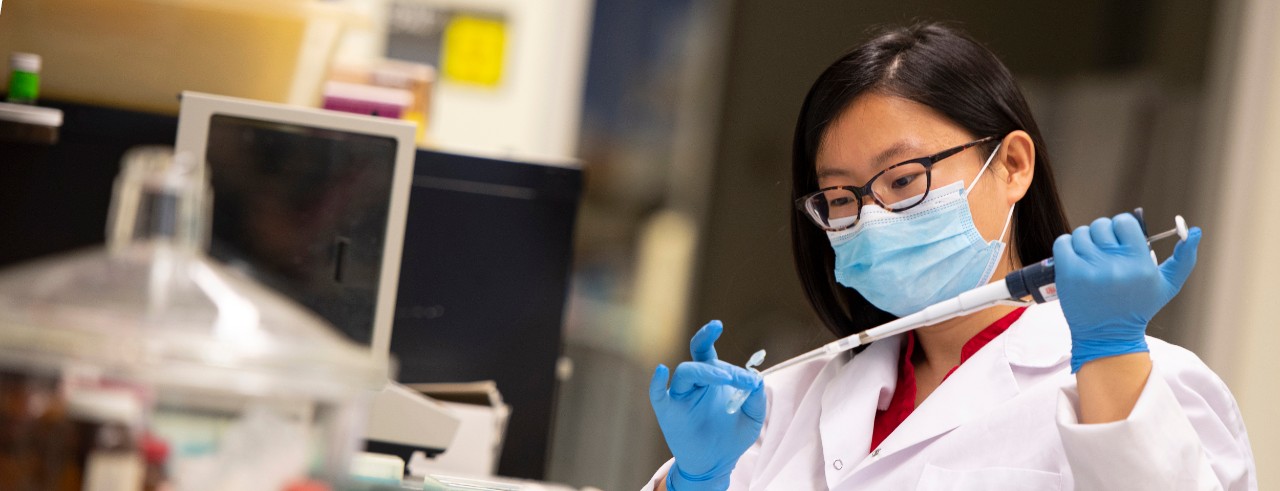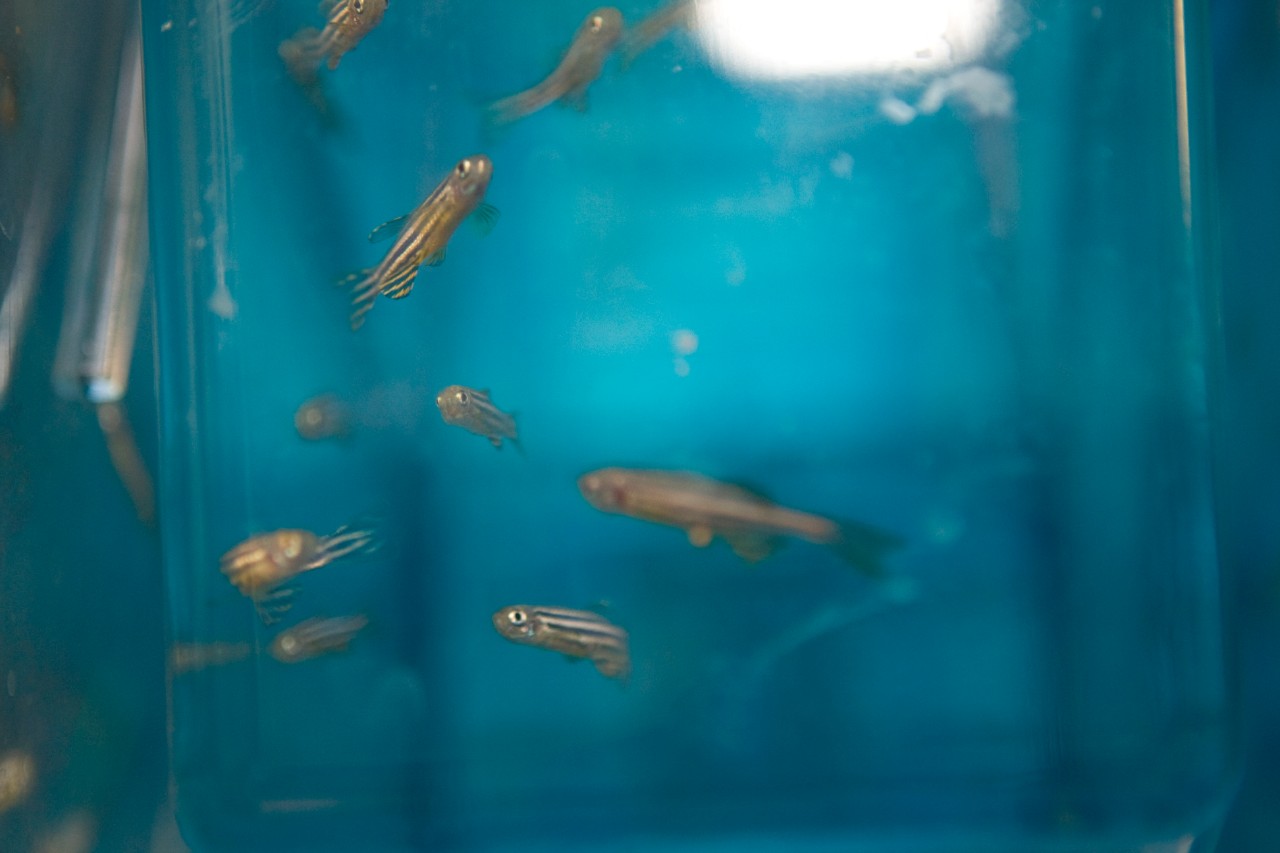
UC student uses zebrafish to study spinal deformities
Research findings in ‘Nature’ show certain gene pairs protect against disease development
Popular in aquariums all over the world, the zebrafish is native to South Asia. But here in a Cincinnati Children’s laboratory, the freshwater variant plays a vital role in scientific discovery.
The iconic stripes of the vertebrate are eye-catching but it’s the transparency of zebrafish embryonic tissue which are most prized by researchers like Oriana Zinani, a fifth-year doctoral student in molecular developmental biology in the University of Cincinnati College of Medicine. The stripes in the embryos show genes functioning like a clock.

Zebrasfish shown in a University of Cincinnati laboratory. Photo by Ashley Kempher/UC Creative + Brand.
Zinani is part of a team of scientists in the laboratory of Ertuğrul Özbudak, PhD, associate professor of pediatrics at UC and Cincinnati Children’s researcher. The team is studying a gene mutation that causes scoliosis, a sideways curvature of the spine that typically occurs in humans just before puberty. Zebrafish eggs are fertilized and develop outside of the mother’s body making visualization with high resolution imaging easier for researchers. Zebrafish and humans share 70% of the same genes.
“We can see exactly what’s happening while it’s happening in zebrafish providing us with insight for human embryonic development,” says Zinani. “My research asks the question, ‘How does the zebrafish embryo robustly achieve precise development in a variety of environments that consider variables such as temperature fluctuations and exposure to different oxygenation levels?’ We realized that embryos need to develop mechanisms to filter out the noise for development, and I focus on what those mechanisms involve.”

Oriana Zinani, a fifth-year doctoral student in molecular developmental biology, is shown in the University of Cincinnati College of Medicine. Photo by Colleen Kelley/UC Creative + Brand.
Scientists for some time have known that specific genes pair up on the same chromosome and appear together or “co-express” in cells and tissues. In humans, at least 10% of genes pair on the same chromosome. Why this occurs has been unknown but the team — including Zinani, Özbudak, Kemal Keseroğlu, a research fellow at Cincinnati Children’s, and Ahmet Ay of Colgate University — did an experiment separating two genes that were paired together to determine the role they may play in spinal column development.
The team’s findings were recently published in the scholarly journal Nature.
Using the gene-editing tool CRISPR-Cas9, the research team performed a simple experiment using a zebrafish model and separated two genes that pair up to control the healthy development of the spine. The separated genes have broken their co-expression. Instead of the nice stripes we are used to seeing zebrafish embryos, we see instead a unified signal, which ultimately leads to failed vertebrae formation.

Ertuğrul Özbudak, PhD. Photo courtesy of Cincinnati Children's.
“With two paired functional genes we see normal healthy development,” says Zinani. “If this were a human the person would have no disease. If we take the normal gene pairs and separate them, without creating any mutation at all, we see disease development under environmental stress.”
Images of a zebrafish with the segmented genes show a jagged vertebrae that’s cracked, broken and fused, explains Zinani. The zebrafish has a diseased phenotype leading to scoliosis. Researchers also raised the zebrafish with separated gene pairs in different temperatures to better understand the impact of environmental pressure on development. Paired genes lead to beneficial spinal development, particularly under environmental stress. Separation of the genes are more likely to lead to deformities of the spine and scoliosis in zebrafish.
“What is also exciting is many genes responsible for the development of diabetes, cancer and autoimmune disorders also present in gene pairs,” says Zinani.”We believe more research will show the importance of those genes maintaining close proximity to their partners. If the process of having genes next to each other influences healthy development, we have a new target to consider in studying disease formation.”
Featured image at top: Oriana Zinani in a UC College of Medicine lab. Photo/Colleen Kelley/UC Creative + Brand
Impact Lives Here
The University of Cincinnati is leading public urban universities into a new era of innovation and impact. Our faculty, staff and students are saving lives, changing outcomes and bending the future in our city's direction. Next Lives Here.
Stay up on all UC's COVID-19 stories, or take a UC virtual visit and begin picturing yourself at an institution that inspires incredible stories.
Related Stories
Ohio could soon make breast cancer screenings more affordable
May 9, 2025
The University of Cincinnati Cancer Center's Ann Brown was featured in Local 12 and Cincinnati Enquirer reports on a bill introduced by Rep. Jean Schmidt in the Ohio legislature that seeks to eliminate out of pocket medical expenses such as copays and deductibles associated with supplemental breast cancer screenings.
PHOTOS: 2025 DAAP Fashion Show
May 9, 2025
Over 900 people attended DAAPFASH25, a fashion show that highlights the collections of the fashion design Class of 2025. The show is now in its 72nd year.
Preparing students for artificial intelligence in education
May 8, 2025
Laurah Turner, PhD, associate dean for artificial intelligence and educational informatics at the University of Cincinnati's College of Medicine, recently joined the For The Love of EdTech podcast to discuss the usage of personalized learning and AI coaches to enhance educational experiences.
